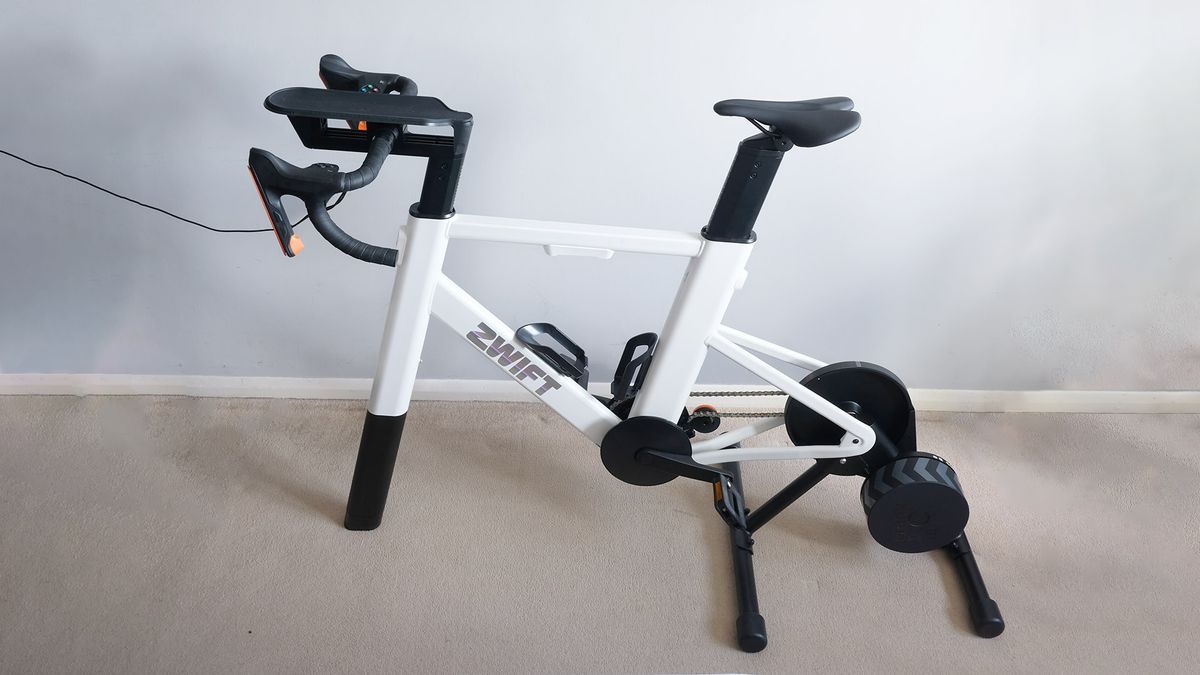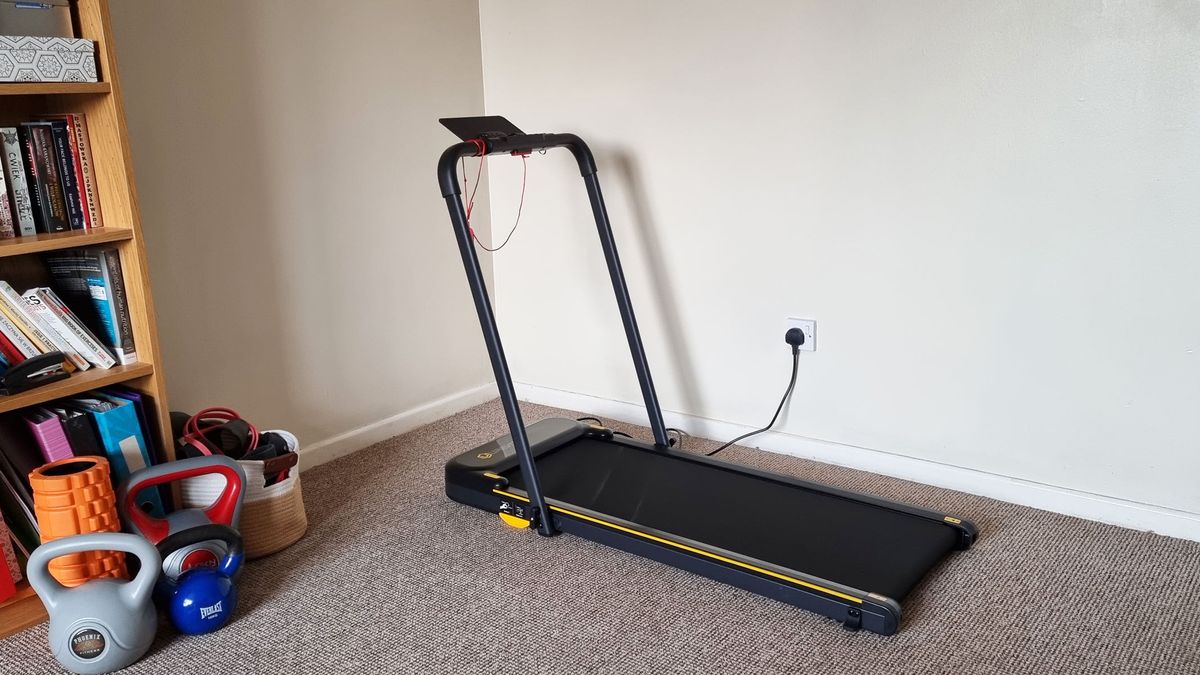Smart bikes became all the rage during the pandemic when so many of us were stuck at home. But there was one consistent issue: they cost a fortune! The Zwift Ride takes some of the sting out. It costs just $1,299.99, compared to $2,549 for the Wattbike Atom or $3,199 for the Tacx Neo. It is also cheaper than most of our favorite exercise bikes.
Zwift manages this by keeping things simple. The Zwift Ride is a smart bike, but it’s also three separate bits. There’s the frame and the smart handlebar, while the brains of the operation is a long-standing Wahoo Kickr Core turbo trainer.
This won’t have made the Zwift Ride design easy, but it must have cut down on the R&D headaches a bit. Is it any good? This is an ideal pairing for any Zwift fan and provides an all-round excellent indoor cycling experience.
The only key issue is that platform-hoppers who also want to check out Rouvy, TrainerRoad, IndieVelo or Fulgaz will find the otherwise super-convenient virtual gear shifting doesn’t work. By buying a Ride you are buying into Zwift more than you are with another smart bike.
Zwift Ride smart bike review
Zwift Ride: Price and availability
Zwift released the Ride in June 2024. It costs $1,299/£1,199/AU$2,299.
It might be considered the culmination of Zwift’s hardware efforts over recent years. Zwift launched an own-branded turbo trainer in 2022, the Zwift Play controller in 2023 and the Zwift Cog virtual gear system later that year. This is the one-stop solution for all your virtual cycling needs. Sort of.
One upgrade you might consider is a pair of proper clip-in pedals — only basic flat ones are included. Zwift’s Ride Tablet Holder is an additional $50/£40, and is highly recommended if you use an iPad/tablet for Zwift. And, as with any bike, you may want to upgrade the seat too, which uses standard rails.
You can also buy the Zwift Ride frame (with handlebar) separately for $799.99/€799.99/£749.99. That’s handy if you already own a compatible Zwift Hub, Kickr Core, JetBlack Victory, Wahoo KICKR v6 or Kickr Move trainer. The Elite Direto and Decathlon D100 will be supported in future too.
Zwift Ride: Design
Key specs
Fit range: 59.8-74.4 in (152-189 cm)
Weight: 78 lbs (35.4 kg)
Accuracy: +/- 2%
Max power: 1,800 W
Max grade: 16%
Connectivity: Bluetooth, ANT+
Flywheel weight: 11.9 lbs (5.4 kg)
A Zwift Ride delivery comes in at least three boxes. More if, like us, you also opt for the overpriced Zwift training mat (£80) and the tablet holder accessory.
Sure, that’s a whole bunch of cardboard. But it also means there should be absolutely no worries if you live in a house or flat without much clearance in the doorways.
I set a timer on my phone when setting the Zwift Ride up, and it was done in just over an hour. You don’t need any special tools. The required one is included. It’s a standard bike-style Allen key too, should you lose the original.
The frame comes largely pre-made: you just slide in the seat post. There’s some minor construction work to do to make the phone- and water-holding front tray by the handlebars, but the only potential issue for most is in interpreting the instructions. They’re good but, in modern flatpack style, are largely a language-agnostic pictorial guide. Still, it’s all fairly easy.
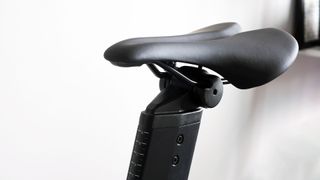
The Zwift Ride frame uses steel tubing, just like other smart bikes, and it’s attractively finished with a two-tone paint job with some flashes of Zwift signature orange. You want to keep this paint intact too, as you’re gong to sweat all over this thing, and steel will eventually rust. But the frame is sturdy, and adopts a chain adjustment system that, unlike a real bike, doesn’t lead to you getting oil all over your fingers when you attach the chain to the turbo trainer.
Zwift also provides a neat guide as to where/how you should set the various adjustable parts, judging by your height. The final setup is not instant but is just as simple as the rest.
Unlike a Peloton, though, the Zwift Ride does not include a display, so you’ll need some form of screen. That could be a phone or a tablet attached to the optional tablet holder add-on. I upgraded to a projector setup a few years ago, which is great, but a much smaller display can work just as well.
Zwift Ride: Features
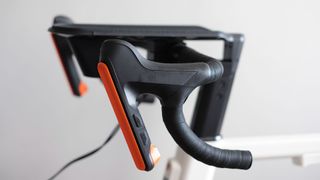
Despite all the branding splashed across the frame, the handlebars provide the meat of the Zwift-specific features in the Zwift Ride. It looks like a set of regular road bike handlebars merged with a video game console pad — and that’s what it is functionally, too. It lets you interact with the Zwift menu system without touching a phone or tablet. And it covers the interactions in-game beyond pure pedaling: gear shifts, braking and steering.
Most Zwifters miss out on the latter two of these. There’s no obvious way to control steering or braking with a real bike hooked up to a smart turbo trainer, short of buying a Zwift Play add-on. The Zwift Ride gives a fuller Zwift experience than not just 95% of regular setups but than some other much more expensive smart bikes too.

I don’t think steering and braking are essential, though. While Zwift has been working on implementations of bike-turning control for years, it’s not a super-important part of the platform. Sure, you can show off by weaving about anywhere on the track. But it’s only a crucial part of the gameplay in a specific (and not particularly well-advertised) off-road route, where you use steering to collect power-ups and avoid obstacles that slow you down.
I tried this route with the Zwift Ride, of course, but found the somewhat stodgy feel of the steering controls made it frustrating. The rubbery click buttons feel just fine for meandering about a road, but come up short in these more video game situations.
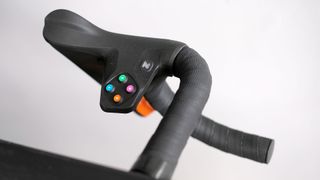
The Zwift Ride also has a rather novel approach to gear changes. It’s all handled electronically, making gear changes silent, which is handy if you want to avoid your turbo trainer annoying neighbors and people you live with. At first, I missed the clunks of my real bike’s gears, but you could just as easily say the Zwift Ride is more like a super-expensive set of electronic gears. It’s certainly easier on the hands.
This gearing system also introduces the Ride’s biggest potential roadblock. It uses proprietary Zwift software, so it won’t work with other platforms like TrainerRoad. To use another platform, you’ll have to attach a bike to the Wahoo turbo trainer here, leaving out the frame entirely.
“Virtual shifting only works with Zwift, so the Zwift Ride has been designed to offer the most complete indoor cycling setup for Zwift,” Zwift’s rep told me.
On the positive side, these handlebars have a pair of integrated batteries and use wireless transmission for minimal fuss. They have a tough rubbery outer that shrugs off sweat, and while I was initially worried I’d press the “Zwift” buttons accidentally during rides, this turned out to be a non-issue.
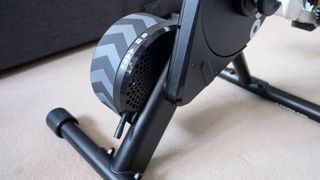
You get a great Zwift experience here but do miss out on some of the more expensive-to-implement features of some rivals. A Tacx Neo Bike has haptic effects for different road surfaces, for example, while a Wahoo Kickr bike tilts up and down to emulate the feel of inclines.
Some people love these features, others say they’re gimmicks. Either way, you don’t get them in the Zwift Ride. The missing rival feature I’d perhaps like to see most here is the side-to-side movement of the Wahoo Kickr Move turbo trainer. But that costs more than the entire Ride setup on its own.
Zwift Ride: Performance
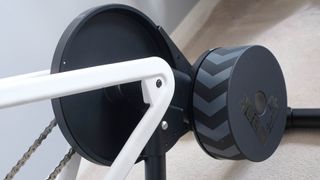
The Zwift Ride’s core performance is all down to the Wahoo Kickr Core, a tried and tested turbo trainer design that has been around since 2018. It’s a great mid-range model, and unless you’re a pro-level cyclist, I don’t think you’ve going to miss the spec downgrades here much. It has a maximum wattage of 1,800 W rather than 2,000W+, and its maximum simulated including is 16% rather than 20%+. Stated accuracy is +/- 2% rather than +/-1%.
Your chances of being able to get remotely close to maxing the Wahoo Kickr Core at all, let alone for doing so beyond a couple of seconds, are slim.
I’m more interested in how the ERG mode feels. This is what’s used for structured workouts, where the resistance is determined not by the terrain of the Zwift game world but by how many watts the particular workout says you should be cranking out at any point.
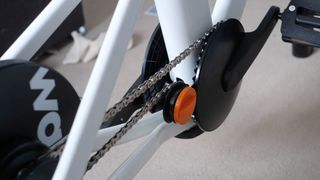
ERG modes can fall down when transitions are too severe, when the wattage overshoots on an increase in effort or when the resistance wobbles all over the place as it tries to hit the target. The Zwift Ride’s Kickr core feels super-smooth, even when going from a minimal effort to a pretty hard interval.
The watts it reports are unnervingly consistent, even if you try to outpace it by suddenly increasing your cadence. I’m fairly sure the Wahoo Kickr must report flattering figures to Zwift (which are then displayed as a three-second average as standard). But the feel of the ERG mode is excellent.
A few times, the Zwift Ride showed a huge dip in output for just a fraction of a second. But it’s not something I’ve felt while actually riding, which has been all smooth sailing in every workout. The 11.9-lb (5.4 kg) flywheel also lends the cycling experience a good sense of weight and realism.
Zwift Ride: Verdict

The Zwift Ride is ideal for anyone who wants a smart bike but is put off by the cost, or for anyone who owns a single bike for indoors and outdoors cycling, and is tired of switching the two. But you had better love Zwift, too: while the Zwift Ride isn’t 100% locked into using the platform, its virtual gear system is.
Still, it offers all the core substance of rival smart bikes at as little as a third of the cost. Heck, you could spend more on a turbo trainer alone.
The Zwift Ride does lack truly expensive features like road-feel haptics, incline motors and sideways motion, but at this price, it seems churlish to complain too loudly.
If Zwift Ride is not for you
If it’s mostly the Zwift optimizations that appeal here, don’t forget you can buy the Zwift Play, which can be retrofitted onto a more ordinary “bike plus turbo trainer” setup. Virtual gear shifts can also be added to certain turbo trainers using Zwift’s Cog + Click accessories.
Direct comparisons to full-on smart bikes barely seem to apply here, as they are at least twice as expensive. But if money is not so much of a worry, check out the Wahoo Kickr Bike, the Tacx Neo Bike or the Wattbike Atom. The Wahoo and Tacx do each have special features that the Zwift Ride lacks and better cross-platform compatibility. But for dedicated Zwift fans, the core experience isn’t going to be all that different.







